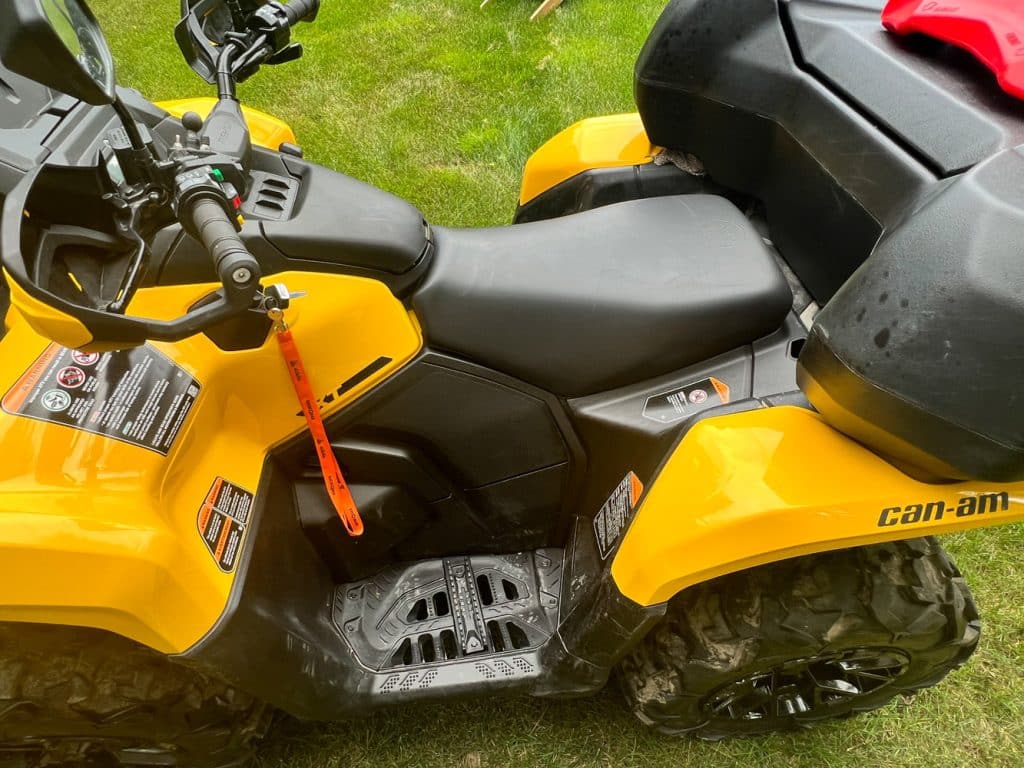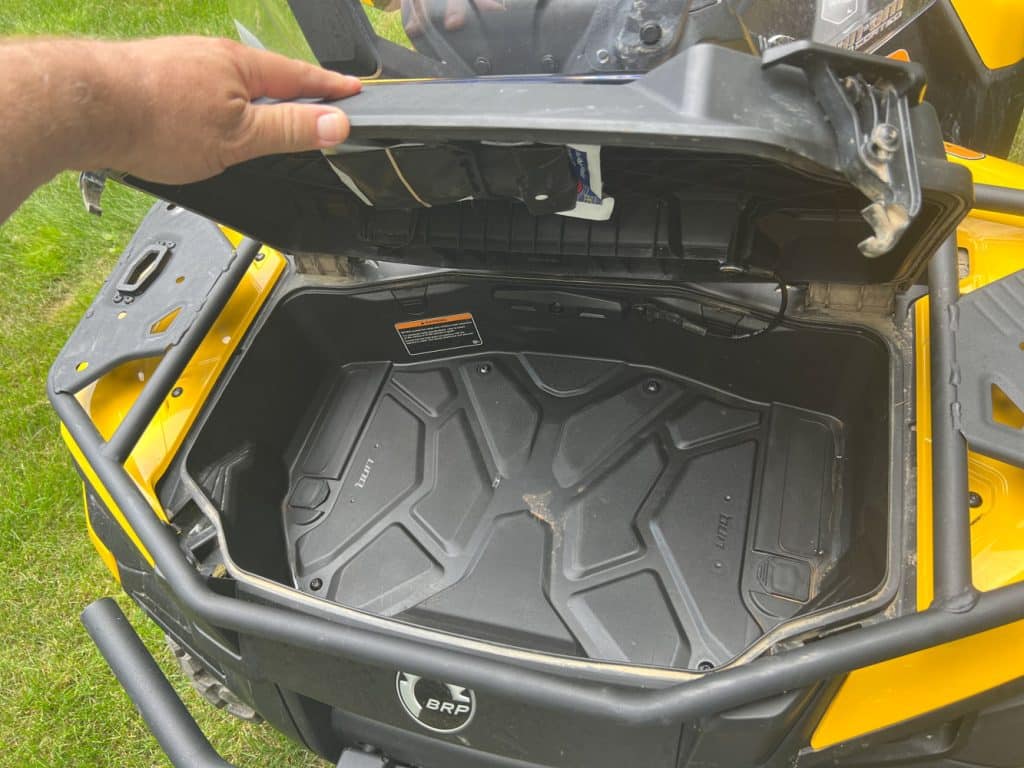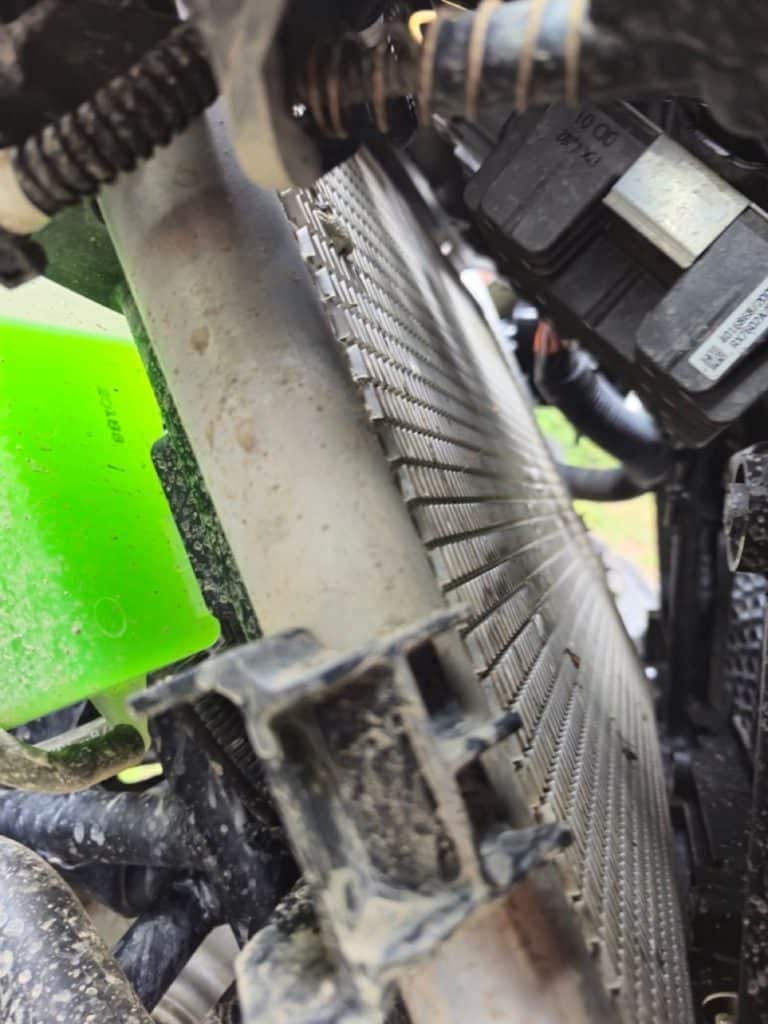Can-Am surprised everyone last spring by introducing a whole new line of mid-displacement quads, the Outlander 500 and 700. These are now the manufacturer’s entry-level models. We were curious to try out this new vehicle in the field. To do so, we put the Outlander 700 XT through its paces in a marathon 1400 km test ride around the Gaspé Peninsula. With such a journey, all the little secrets of the machine will be revealed. What’s more, Can-Am has agreed to fit the vehicle with Linq equipment: a windshield and a rear trunk.

Mechanical design: engine and transmission
Can-Am is introducing in its new Outlanders a single-cylinder engine that we’ve already seen in UTVs. This decision has caused a stir among Can-Am customers. Indeed, switching from a 570 cm3 twin-cylinder to a 700 cm3 single-cylinder is perceived as a step backwards in terms of refinement and versatility. This allegation remains to be verified during the test ride.


The HD7 engine has a displacement of 650 cm3 , 50 hp and 41 lb-ft of torque. This makes the HD7 the most powerful of all mid-displacement quads.
The belt drive also received special attention from the engineering department. Clutch pulleys have been revised for improved durability and faster throttle response. In addition, the manufacturer claims to have worked to reduce transmission noise and vibration. We can confirm that Can-Am has fully succeeded on this front: all you hear are the tires and the engine. No more transmission hissing gear noises. Fresh-air management has been optimized to control transmission temperature. The result is longer belt life. The transmission and engine air intakes are located at the highest point just below the instrumentation. This is a judicious technical choice that will allow you to venture deep into the water without worry.
Chassis and drive gear
Four-wheel drive is standard on almost all models (the entry-level Outlander 500 is 2WD). In the case of the Outlander 700 XT, the front differential is the self-locking Visco-Lok QE, which locks automatically when the situation calls for it.
The powertrain is housed in an all-new chassis that offers good rigidity thanks to a high-quality steel alloy. The manufacturer had heat management in mind in its design. The engine has been placed in the frame with the piston facing rearwards, similar to the Arctic Cat Alterra 600. In addition, panels completely close off the engine opening on each side to prevent heat from roasting the driver’s calf.
Suspensions and wheels
The suspension is now independent, with double wishbones at all four wheels to ensure comfort and control. To limit vibration, rubber bushes have been added to the attachment points. Wheel travel is 9.75 inches at the front and 10.25 inches at the rear. Ground clearance is now a remarkable 12 inches. Finally, to improve cornering stability, the vehicle’s track has been widened by 2 inches to 47.6 inches.



As for tires, the Outlander 700 XT is fitted with 14-inch aluminum rims topped with 26-inch XPS Trail Force tires. These one are moderately noisy and offer adequate but not exceptional grip in mud. Resistance is more than adequate, as they almost withstood a full lap of the Gaspé Peninsula without a puncture.
Body and finish
The new body design is sober and consensual. The line is a blend of the larger Outlander with accents of the Suzuki King Quad. Compared to the version it replaces, it is larger. The fenders are high and wide, offering first class protection for the rider. At this level, the only way to get splashed with an Outlander 700 is to run into puddles that will come back over the windshield. Even then, your feet will stay perfectly dry. Also noteworthy is the total absence of residual engine heat on the driver’s legs. The idea of orienting the engine towards the rear is a judicious one.


You sit high on an Outlander 700. The riding position is natural, thanks to the well-designed handlebar/seat/footrest triangle. The seat is one of the most generously padded in the industry, offering excellent comfort. Thanks to the reduced width of the tank, the rider has plenty of room to move around the machine. Assembly quality is meticulous, and the plastic finish is as smooth as a Honda product, which is exceptional.


The black grille is not too massive and blends in well with the overall design of the front end. Can-Am decided to install LED lighting throughout. There are four square LED headlights at the front and a parking light at the rear.
Storage, More Storage
Can-Am has worked hard to give its Outlander 700 XT more convenience for its owner, by integrating compartments that are appreciated as the trip progresses. Three watertight compartments are provided.



The first is located under the front luggage rack and has a capacity of 30 liters. The second is located in front of the driver in the false fuel tank. With the XT, the third compartment is located in a console above the indicator dial. This console is at eye level and can be used to hold a cell phone or GPS. Can-Am has also adapted to the new realities of electronic devices by fitting a useful USB socket in the glove compartment. With Can-Am’s 145-liter Linq trunk, I was looking forward to seven days trip with this vehicle.
Driving experience
When you drive a vehicle intensively for 1400 kilometers, you either love it or hate it. I personally liked the Outlander 700 XT, and here’s why.
Powertrain
First of all, the powertrain’s performance is really on the point. True, the engine is a single-cylinder. What’s more, its sound is very similar to that of a King Quad 750 or Grizzly 700. On the other hand, even if you don’t feel the raw power of a big twin, I never had the impression of a lack of power with this ATV. The power curve is full and consistent throughout. Torque is also abundant, and the vehicle holds its speed on long climbs. It’s even possible to accelerate in these conditions. The transmission has a clutch delay when shifting out of Park and into gear. A “clock” sound is heard when the clutch is engaged. From then on, the transmission’s performance is flawless: smooth, always in the optimum ration gearing, with good engine braking and quiet. Yes, quiet! On the Outlander 700, there’s no more clutch or gear hissing noise. A Can-Am first.

What about the 570? Apart from the happy note of the 570’s exhaust, the single-cylinder 700 does the job just as well. So we can turn the page on the 570 without regret.
Trail handling and comfort

Trail riding is a very pleasant experience, whatever the pace required. We mentioned the neat driving position above, but the dynamic capabilities are spot on. The power steering is precise and allows the vehicle to be positioned very precisely. There’s never a jerk in the handlebars. The rigid chassis and suspension work together to get the job done. Damping is effective without being too soft. It won’t give unpleasant bounces on pronounced bumps. The vehicle holds its course well on trails, maintaining its attitude. With plenty of room for weight transfers, you’ll find yourself cruising along at a very good pace, effortlessly. And speaking of cadence, the engine has no problem sustaining the appreciable speeds imposed by big twins on forest roads. In short, the vehicle’s handling is highly competent, whatever the environment.

Wide range of accessories
Can-Am is all about personalizing the vehicle to suit your needs. No fewer than 75 Linq-compatible accessories are available for every conceivable use. At our request, Can-Am equipped the vehicle with a 145-liter trunk and a windshield. The duration of the test enabled us to evaluate the performance of this equipment in real-life situations.


- The windscreen is mounted high behind the instrument pod. The appearance is innovative and the canopy does not cause distortion. However, many will find it too high. On the first day, we lost a plastic molding. In addition, as the week progressed, the weight of the high windscreen caused the equipment to sway incessantly from left to right. We noticed that the instrument pod’s fastenings had become looser.

- The 145-liter trunk has ample capacity, and the regular shapes help to organize the load efficiently. The two rubber clips are sturdy and easy to handle. It’s perfectly sealed against dust and water, thanks to an efficient gasket. However, when it rains on the trunk, the water that runs off the lid empties into it when you open it. Knowing this, you can always wipe it clean before opening it. Linq fasteners are handy for putting the box on and taking it off the ATV, but are not vibration-resistant. There are four fasteners to secure the trunk: two at the front and two at the rear, which are twist locks. Those at the front are like a mortise-and-tenon assembly: a tongue slides into a receptacle. However, this assembly shakes with vibration and rattles so much that I thought I was losing the trunk. We slipped rags into the fixings to finish the trip.
In short, while the vehicle appears to have been carefully tuned by the engineering department, the same cannot be said of the accessories department. At the price we’re asking for this equipment, we think these shortcomings need to be rectified without delay.
We liked :
– The vehicle’s overall homogeneity
– HD7 engine efficiency
– Practical storage space
We liked less :
– The sturdiness of Linq accessories
– The gas accelerator is too stiff
Summary
The riding of the new Outlander 700 XT was a surprisingly satisfying experience. This is an attractive model whose design has been well thought out by the project engineers. Whether in terms of perceived quality, ride noise control, leg heat control, overall comfort or powertrain performance, the vehicle delivers. Bravo Can-Am!
The Raven Media team would like to thank Can-Am Off Road for the loan of the vehicle that made this test possible.







